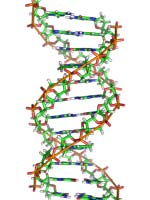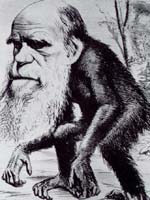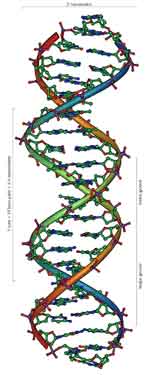According to new research, chimpanzee genes have shown more adaptive changes than those of humans. The media widely reported the results as evidence that chimps are ‘more evolved’ than humans. But as I discuss here, these headlines are putting words into the researchers’ mouths.
 Since the time when humans and chimps evolved from our common ancestor, our species appears to have come on by leaps and bounds. We walk on two legs, we speak using languages and while there is no doubt that chimps are intelligent, there is even less doubt that our brainpower outclasses theirs.
Since the time when humans and chimps evolved from our common ancestor, our species appears to have come on by leaps and bounds. We walk on two legs, we speak using languages and while there is no doubt that chimps are intelligent, there is even less doubt that our brainpower outclasses theirs.
For years, scientists have assumed that our advanced abilities must be reflected in our genetics. After all, traits like intelligence and language give us great adaptive advantages. They should therefore be mirrored by similarly large changes in the human genome, compared to the chimp one.
Not so. Researchers at the University of Michigan sifted through the human and chimp genomes for signs of positive selection – the process where natural selection firmly embeds new mutations because of the advantages they provide. They found that the chimp genome contains 50% more positively-selected genes than the human one.
While earlier studies have compared individual human and chimp genes, this is the first to do a proper census. Margaret Bakewell and colleagues looked at almost 14,000 genes in both species.
The project was given a valuable push by the recent publication of the fully-sequenced rhesus macaque genome. The macaque – a type of monkey – is an evolutionary cousin of both humans and chimps, and provides a useful comparison.
 If the team found a difference in the human and chimp genes, the macaque version can tell them which version is closest to the ancestral one. Previously, scientists had to make do with the mouse, a much more distantly related animal. The macaque’s presence gives the analysis greater accuracy.
If the team found a difference in the human and chimp genes, the macaque version can tell them which version is closest to the ancestral one. Previously, scientists had to make do with the mouse, a much more distantly related animal. The macaque’s presence gives the analysis greater accuracy.
Bakewell failed to find any noticeable differences in the function of positively-selected genes in humans and chimps. Both species even had similar proportions of positive changes among the genes that control the brain and nervous systems.
The reasons for this surprising result are unclear, but Bakewell feels that population sizes may hold the answer. For most of their evolution, chimpanzees have enjoyed a larger population size than humans have. It’s only recently that our numbers have ballooned to unfeasible proportions.
According to evolutionary theory, beneficial genetic changes are more quickly established in a population if it is larger. But in smaller groups, random genetic changes can trickle down through generations without being properly weeded out. This ‘genetic drift’ could explain why humans have fewer positively-selected genes than chimps do.
An alternative theory is that many of the human genetic changes that provide us with the greatest advantages may be relatively new developments. It is only recently in our history that we spread around the world from our origins in Africa, and as such, new genetic innovations may not have become established in the population as a whole.
A third theory, which I’m putting forward myself, is that the genetic changes responsible for our most human traits, may lie among stretches of DNA missed by this study. Recently, a study showed that one of the most important ‘genes’ in human evolution lies within our so-called junk DNA and controls the development of our brains. Clearly, we still have much to learn.
 Nonetheless, the study helpfully shows that evolution is not necessarily about progress. It’s not an inexorable march toward some gleaming future. It’s about change, regardless of direction or result.
Nonetheless, the study helpfully shows that evolution is not necessarily about progress. It’s not an inexorable march toward some gleaming future. It’s about change, regardless of direction or result.
Somewhere along the line, the word ‘evolved’ started to gain a false value. It became an indicator of positive progress, so that claiming to be ‘more evolved’ than a peer is to claim superiority.
A huge number of newspapers and magazines reported this story under the headline of ‘Chimps more evolved than humans’. And while that may be technically reasonable, the inferences made were anything but.
The inherent values placed upon the phrase ‘more evolved’ clearly emerged in the reaction to the story. Some suggested that humans were obviously ‘less evolved’ given for reasons ranging from pollution to capitalism. Meanwhile, creationists and ID-supporters smelled blood in the water, and claimed that such as blatantly preposterous conclusion proved that evolution was nonsense.
Of course, no such conclusions were actually made by the study itself. In the light of the proper progress-free meaning of the word ‘evolution’, hese results are not preposterous, but fascinating. We should use them to drive a nail in the coffin of phrases like ‘evolutionary race’ or ‘more evolved’, at least in its value-laden non-scientific sense.
Reference: Bakewell, Shi & Zhang. 2007. More genes underwent positive selection in chimpanzee evolution than in human evolution. PNAS 104: 7489-7494.
Technorati Tags: chimp, chimpanzees, chimp genes, chimps humans evolved, chimps evolved, more evolved, science
Filed under: Animal evolution, Animal kingdom, Being human, Chimpanzees, Evolution, Genetics, Human evolution, Junk DNA, Mammal evolution, Mammals, Primates, Science & society | 5 Comments »
![]() The spinal column that runs down your back is an identity badge that signifies your membership among the vertebrates – animals with backbones. Vertebrates have arguably the most complex bodies and genomes of any animal group and certainly, our lineage has come a long way from its last common ancestor.
The spinal column that runs down your back is an identity badge that signifies your membership among the vertebrates – animals with backbones. Vertebrates have arguably the most complex bodies and genomes of any animal group and certainly, our lineage has come a long way from its last common ancestor. The closest evolutionary cousins of the vertebrates are simple aquatic creatures such as the jawless lancelets and the sac-like, immobile sea squirts. How did these simple body plans diversify into the vast array of sophisticated forms wielded by today’s fish, amphibians, reptiles and mammals?
The closest evolutionary cousins of the vertebrates are simple aquatic creatures such as the jawless lancelets and the sac-like, immobile sea squirts. How did these simple body plans diversify into the vast array of sophisticated forms wielded by today’s fish, amphibians, reptiles and mammals?









 Two months ago, a
Two months ago, a 




